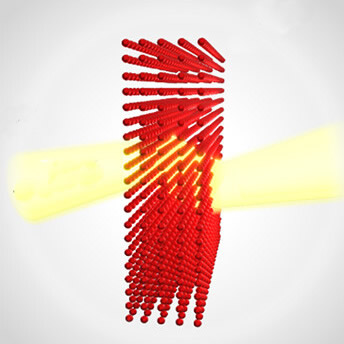A New Meta: Realizing Negative Refraction of Light Using Atomic Media
- A novel platform towards applications such as powerful lenses and cloaking devices -

Researchers at NTT and Lancaster University have established large-scale microscopic simulations to reveal that that cooperatively responding atoms, ordered in a lattice, can achieve negative refraction—a phenomenon with the potential for powerful technologies such as cloaking and superlenses that focus light beyond the diffraction limit. Artificially fabricated structures, called metamaterials, have conventionally been used to demonstrate the negative reflection of light. However, they suffer from limitations of material absorption and fabrication imperfections at optical frequencies. Our approach, based on precisely structured and readily tunable atomic lattices, is free from absorption losses and offers unprecedented control over light-matter interactions, paving the way for near-term exploration and development of negative refraction's transformative potential.
=> Press Release
=> Theoretical Quantum Physics Research Group
Highlights
- Researchers at NTT and Lancaster University have demonstrated with theory that negative refraction of light is possible in cooperatively responding atoms, trapped in a lattice using lasers.
- Atomic lattices offer an alternative platform to conventional metamaterials, where achieving negative refraction of light is hindered by material dissipation and fabrication imperfections.
- This work paves new paths toward transformative applications, including optical cloaks and superlenses, of negative refraction.
Background
Refraction —the familiar bending of light at the boundary between different materials—is a common phenomenon. Negative refraction, however, is the curious case where light bends in the opposite direction (Fig.1) to what is typically seen in nature. This unusual effect has been a major driver of decades of research due to its potential in groundbreaking applications, such as superlenses that focus light beyond the diffraction limit and cloaking devices that can render objects invisible.
Metamaterials—artificially fabricated structures—have been a central approach in efforts to overcome the limitations of natural materials and achieve negative refraction. These materials typically use resonators*1 that are designed to interact with both the electric and magnetic fields present in light. When carefully constructed and arranged at the nanoscale, their combined emission causes the light to bend backwards. Despite progress in conventional metamaterials, however, negative refraction and its practical applications have remained constrained at optical frequencies due to dissipation of light and fabrication imperfections.
Results of Our Work
Now, researchers at NTT and the University of Lancaster have theoretically demonstrated that negative refraction of light can be achieved using cooperatively responding atoms, arranged in a lattice (Fig. 2), which eliminates a reliance on conventional metamaterials. These precisely arranged atomic crystals offer exceptional control over the interactions between light and matter, providing a pristine, clean medium free from absorption losses and fabrication imperfections. This unique combination of properties makes atomic lattices a promising alternative to metamaterials for exploring and developing applications, such as optical cloaks and superlenses, of negative refraction.
Details
This new approach uses laser-trapped atoms that, in state-of-the-art experiments, can be arranged to form a perfectly ordered "crystal". Here,each atom acts as an oscillating electric dipole*2 capable of both emitting and absorbing radiation. Closely spaced atoms strongly interact with one another through the light they radiate, and these interactions give rise to a collective optical response that cannot be predicted by considering atoms in isolation. By tuning the lattice and the incident beam, negative refraction of light can be achieved in the cumulative radiation of these interacting atoms.
To theoretically demonstrate this, researchers established large-scale simulations that precisely predict how atoms respond to laser light, including how they are excited and how they emit radiation. These are made possible by a detailed microscopic description of the atomic medium that accurately captures all light-induced atom-atom interactions. Using these simulations, researchers analyzed the propagation of a beam of light within the atomic medium and observed its negative refraction across a wide range of beam and lattice configurations, with two specific cases of five layers and twenty-five layers shown in Fig. 3. In short, negative refraction can be achieved and studied in a controlled and variable setting.
Outlook
This approach leverages near-term advancements in atomic lattice capabilities, offering a path forward for exploring and developing technologies based on negative refraction such as superlenses and optical cloaks. Atomic lattices further offer a powerful platform for both deepening our understanding of optics and expanding possibilities beyond the current metamaterial paradigm. Featuring strong interactions and single-photon nonlinearities*3, they could excel as tools for quantum simulations and interfaces, with implications even for quantum information processing technologies.
Journal Information
Journal: Nature Communications
Title: Negative refraction of light in an atomic medium
Authors: Lewis Ruks (NTT Basic Research Laboratories); Kyle Ballantine, and Janne Ruostekoski (Lancaster University)
Technical Language
- *1 ... Resonator
- a structure that confines light by repeatedly reflecting it internally, creating specific patterns. Two parallel mirrors are a basic example.
- *2 ... Oscillating electric dipole
- The periodic motion of positive and negative charge, which creates a changing electromagnetic field. In atoms, this is realized in the electron cloud shifting relative to the nucleus.
- *3 ... Single-photon nonlinearity
- A quantum effect where the presence of a photon changes how an atom interacts with additional light, mediating an interaction between two photons that would not normally interact.










